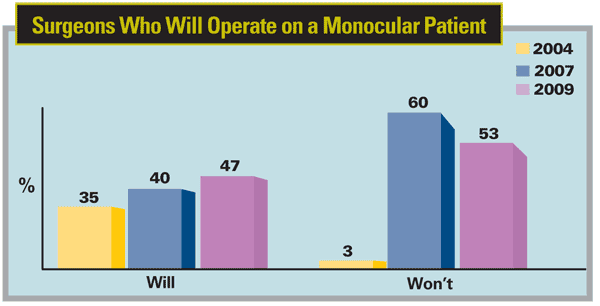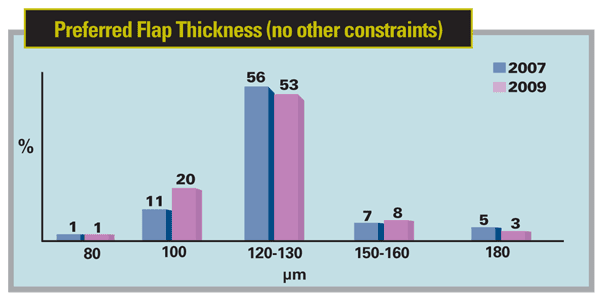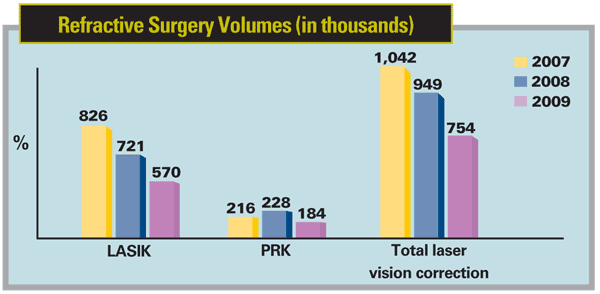The members of the American Society of Cataract and Refractive Surgery are getting a little more aggressive in certain areas of their refractive surgery practices, but are playing it safe in others, according to the latest survey of the organization's membership. In the case of a one-eyed patient who desires refractive surgery, for example, almost half of the surgeons say they'd perform the surgery. On the other hand, when it comes to the thickness of the LASIK flap, surgeons are increasingly more conservative, and more of them are moving toward thinner flaps each year.
For the current survey, which was emailed to 4,768 U.S. ASCRS members in 2009, 518 surgeons (14 percent) responded. 2009 was also the first year the survey was done completely by e-mail, according to

Presbyopic Lenses
It's not clear why, but the percentage of surgeons who prefer to use a clear lens exchange/premium intraocular lens implantation for the non-cataract presbyopic patient decreased from 36 percent on the 2007 survey to 23 percent on the current one. The most popular option was monovision, chosen by 49 percent of the surgeons. "The take-home point for me is if you're going to be looking at patients who are 45 and older, and they desire just refractive surgery and not cataract, the preferred surgery isn't going to be a premium IOL," says Dr. Duffey. "This isn't necessarily because premium IOLs aren't as good as we want them to be, but rather because you have to go through a major change from performing a corneal procedure to doing an intraocular one. That's why I think monovision continues to win out for presbyopes without cataracts, because you can do laser vision correction on those people and not have to do an intraocular procedure and introduce the risk of endophthalmitis, CME, etc.
"The other thing that affects that 23-percent figure for premium lenses in these patients is the percentage of hyperopes vs. myopes, he continues. I'm a good example of this, but it's true across the board. In a 45- to 55-year-old, for example, I'll immediately reach for the refractive lens exchange/presbyopic IOL, but in the myope I typically won't. In the myope, I'll instead do monovision. Monovision is one-quarter of the cost of the IOL implantation, is done on the surface rather than inside the eye and entails the surgeon having to operate on only one eye. Though it's still a little bit of a mystery as to why it was 36 percent in the previous survey but 23 percent on this one, if anything maybe there's increased conservatism leading people to see the benefits of monovision."
However, Dr. Duffey makes a distinction between choosing a presbyopic IOL for a refractive indication and choosing one for cataract. "In Dr. Leaming's ASCRS cataract surgery survey, the estimated usage of presbyopic IOLs has increased since 2007. In that year, surgeons estimated they used 299,000 presbyopic lenses. In 2008 it was 310,000, and in 2009 it was 410,000," he says. "If you're planning a cataract procedure in these patients, then a premium IOL makes sense."

Surgical Volumes
As many surgeons are witnessing firsthand, laser vision correction volumes continue to decrease, and the ASCRS survey bore that out, showing a 21-percent drop between 2008 and 2009, from 949,000 cases of PRK and LASIK to 754,000.
"There's no sign of recovery in volumes," comments Dr. Duffey. "The consumer confidence index drives refractive surgery, and that index is poor and I think it will remain poor for a while. The top factor influencing this decrease is the economy, but another factor is that LVC is still getting some bad press out there, though I don't understand why. The overall satisfaction rates are around 95 to 96 percent, and even 99 percent in some military studies. The bad press is really from a limited number of people who are vocal in terms of websites, FDA complaints and the like."
Monocular Surgery
Dr. Duffey says ASCRS surgeons seem to be becoming more aggressive than in the past, with the percentage of them who say they'd perform refractive surgery on a patient's remaining good eye nearing 50 percent for the first time since he started conducting the survey. However, he says it probably won't get much higher than that.

"On the survey of surgeons from the International Society of Refractive Surgery, the percentage who will operate on a monocular patient has always run around 50 percent," says Dr. Duffey. "The ISRS has always been a more aggressive group, but I think the ASCRS surgeons who are responding to the survey are a little bit more aggressive than in the past, so I think their answers are starting to harmonize with the ISRS's.
"Personally, I used to perform monocular surgery and was comfortable with it, but now I'm not," Dr. Duffey continues. "If the patient's worse eye won't correct to 20/40 or better, I won't do elective refractive surgery on the good eye. This is because if I perform the surgery and there's a problem with the good eye, and the bad eye can't be corrected to better than 20/60, I will have significantly changed the patient's life for the negative. If around half of ophthalmic surgeons won't do it, I'm in the conservative 50 percent.
"That's one thing this survey has helped me with, and I think helps other surgeons, too," Dr. Duffey continues. "Specifically, ophthalmologists can take a look and see what their colleagues are doing around the country and ask themselves, 'Am I comfortable with where I am in terms of aggressiveness?' I hope this aspect of the survey helps some surgeons establish their standard of care."



